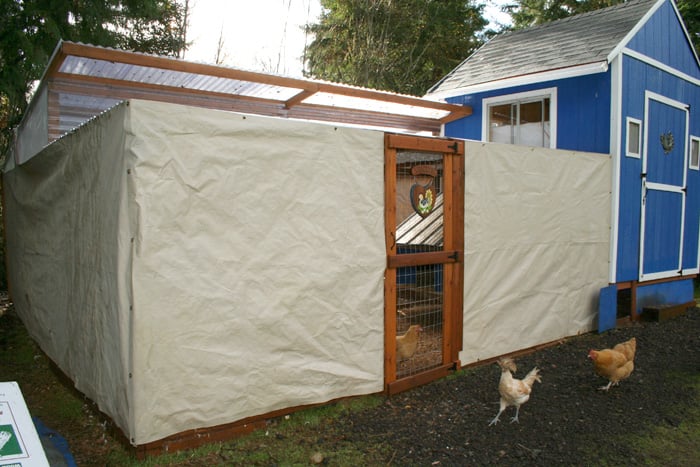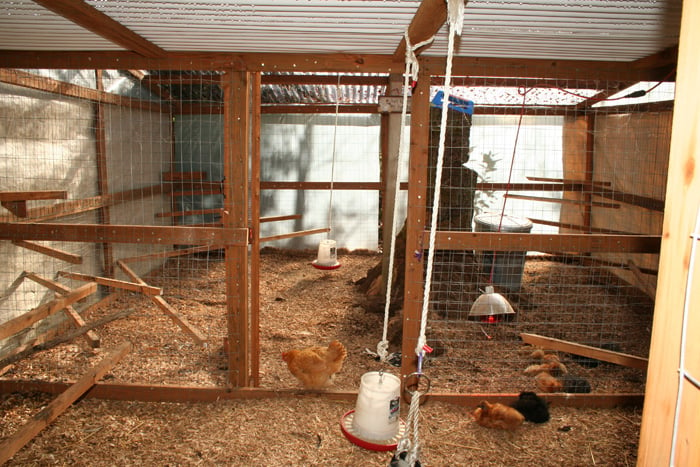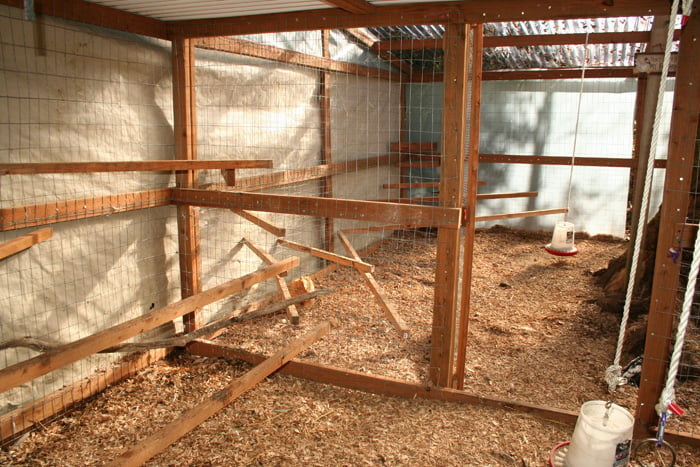While we had some sunny crisp autumn days, we winterized our coop as a necessity to guard against the Seattle rain. As some of you may know, we can get rain 3 months straight. Fortunately, we don't have minus 0 temps, so we didn't insulate the coop. However, adding tarps to all the sides of the enclosure was a necessity.

All the sides have the costco barn tarp on. We simply used the grommets that came with the sides, and attached them to the screws on the frame.

Even the bottom of the 8x8 house needed to be shielded on the sides to prevent windy drafts and the snow from bugging the peeps too much. We reused thick plastic sheets which we cut from a swimming pool liner. We don't have any snow yet, but it might come and stick around, like the winter of 07-08.

We wanted to create a greenhouse effect with the plastic sheets. So we used a translucent plastic at the top (triangle sides) and left the opaque costco barn sides for the enclosure. This will stop the rain and wind from going into the enclosure, thus creating more footage and dry space for the birds.

We left the back wall plastic sheet translucent because that was the sunny side. It will brighten the enclosure within and make it cheerful. Let's hope the plastic stays robust through the seattle wind storms. We might have to work at that. Under the roof, where the beams meet the back wall, there are gaps in there in between the corrugated plastic roofing. That will help with air circulation.

We decided to leave the door open for now, no tarp yet. It seems to help with light from this side, and also helps with air circulation.

From the inside looking up. We created an overhang with the roof. That helped a lot with keeping the rain out. It is quite amazing actually, stepping into the enclosure, I can feel a distinct temperature difference. It really is cozy and warm in there.

The light from the sun coming in through the back helps, and the transparent corrugated roof lets in lots of light too. Makes it more appealing for me to spend time with my peeps in winter.

We found out that on rainy days, the chickens, of all the age groups and sizes, love to dry their feathers under the heat lamp. I know this is a luxury, but I don't mind spoiling my peeps. If it keeps them warm, and happy, and we can afford it, then why not?

I think my chickens are spoilt rotten.

We noticed that on wet eeky days, the chickens improvised by taking their dust baths in the enclosure where it is dry. They just ruffle up all their shavings, digging the earth around, and just have a happy time. I don't mind, and they seem happy.

View from the human door to the enclosure.

Let winter come!! We're ready. Keeping fingers crossed.

All the sides have the costco barn tarp on. We simply used the grommets that came with the sides, and attached them to the screws on the frame.

Even the bottom of the 8x8 house needed to be shielded on the sides to prevent windy drafts and the snow from bugging the peeps too much. We reused thick plastic sheets which we cut from a swimming pool liner. We don't have any snow yet, but it might come and stick around, like the winter of 07-08.

We wanted to create a greenhouse effect with the plastic sheets. So we used a translucent plastic at the top (triangle sides) and left the opaque costco barn sides for the enclosure. This will stop the rain and wind from going into the enclosure, thus creating more footage and dry space for the birds.

We left the back wall plastic sheet translucent because that was the sunny side. It will brighten the enclosure within and make it cheerful. Let's hope the plastic stays robust through the seattle wind storms. We might have to work at that. Under the roof, where the beams meet the back wall, there are gaps in there in between the corrugated plastic roofing. That will help with air circulation.

We decided to leave the door open for now, no tarp yet. It seems to help with light from this side, and also helps with air circulation.

From the inside looking up. We created an overhang with the roof. That helped a lot with keeping the rain out. It is quite amazing actually, stepping into the enclosure, I can feel a distinct temperature difference. It really is cozy and warm in there.

The light from the sun coming in through the back helps, and the transparent corrugated roof lets in lots of light too. Makes it more appealing for me to spend time with my peeps in winter.

We found out that on rainy days, the chickens, of all the age groups and sizes, love to dry their feathers under the heat lamp. I know this is a luxury, but I don't mind spoiling my peeps. If it keeps them warm, and happy, and we can afford it, then why not?

I think my chickens are spoilt rotten.

We noticed that on wet eeky days, the chickens improvised by taking their dust baths in the enclosure where it is dry. They just ruffle up all their shavings, digging the earth around, and just have a happy time. I don't mind, and they seem happy.

View from the human door to the enclosure.

Let winter come!! We're ready. Keeping fingers crossed.





